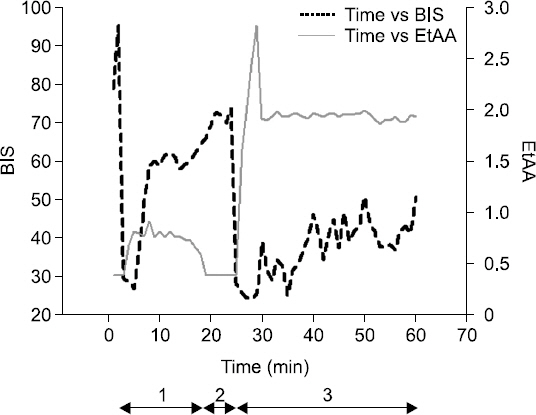Anesth Pain Med.
2017 Apr;12(2):183-186. 10.17085/apm.2017.12.2.183.
Unexpected anesthetic leakage from a damaged O-ring on the Selectatec back bar: A case report
- Affiliations
-
- 1Department of Anesthesiology and Pain Medicine, International St. Mary's Hospital, Catholic Kwandong University of Korea College of Medicine, Incheon, Korea.
- 2Department of Anesthesiology and Pain Medicine, Asan Medical Center, University of Ulsan College of Medicine, Seoul, Korea. jyounbang@gmail.com
- KMID: 2379742
- DOI: http://doi.org/10.17085/apm.2017.12.2.183
Abstract
- The Selectatec mounting system was devised to provide easy and quick on-site fitting of various vaporizers for the anesthetic machine. However, a quick changing system for the vaporizer can also damage the O-ring due to friction between the vaporizer and the Selectatec back bar. We herein report a case of an unexpected anesthetic gas leakage from a damaged O-ring on the Selectatec back bar, which resulted from exchanging the vaporizers between two operations. In cases using the Datex Ohmeda machine, it is not easy to detect leakages from the vaporizers because of the location of the check valve near to the fresh gas outlet. This complicates the use of the positive pressure leakage test to detect a low pressure system leakage on the Selectatec back bar. We recommend the preanesthetic negative pressure or low-flow leakage test to detect a low pressure leakage when exchanging vaporizers on the Selectatec system.
Keyword
Figure
Reference
-
1. Avidan MS, Mashour GA, Glick DB. Prevention of awareness during general anesthesia. F1000 Med Rep. 2009; 1:DOI: 10.3410/m1-9.2. Smith FD. Management of exposure to waste anesthetic gases. AORN J. 2010; 91:482–94. DOI: 10.1016/j.aorn.2009.10.022. PMID: 20362214.3. Cassidy CJ, Smith A, Arnot-Smith J. Critical incident reports concerning anaesthetic equipment:analysis of the UK National Reporting and Learning System (NRLS) data from 2006-2008*. Anaesthesia. 2011; 66:879–88. DOI: 10.1111/j.1365-2044.2011.06826.x. PMID: 21790521.4. Subrahmanyam M, Mohan S. Safety features in anaesthesia machine. Indian J Anaesth. 2013; 57:472–80. DOI: 10.4103/0019-5049.120143. PMID: 24249880. PMCID: PMC3821264.5. Tanaka M, Yamaura K, Higashi M, Hoka S. Leakage of sevoflurane from vaporizer detected by air monitoring system:a case report. J Clin Monit Comput. 2013; 27:629–31. DOI: 10.1007/s10877-013-9479-9. PMID: 23709020.6. Pandit JJ, Jakubowski P, Wait CM. Broken O-ring causing hypoventilation. Anaesthesia. 1993; 48:1114–5. DOI: 10.1111/j.1365-2044.1993.tb07563.x. PMID: 8285353.7. Berry PD, Ross DG. Missing O-ring causes unrecognised large gas leak. Anaesthesia. 1992; 47:359. DOI: 10.1111/j.1365-2044.1992.tb02195.x.8. Lum ME, Ngan Kee WD, Robinson BJ. Fault in a Selectatec manifold resulting in awareness. Anaesth Intensive Care. 1992; 20:501–3. PMID: 1463182.9. Myers JA, Good ML, Andrews JJ. Comparison of tests for detecting leaks in the low-pressure system of anesthesia gas machines. Anesth Analg. 1997; 84:179–84. DOI: 10.1097/00000539-199701000-00032. PMID: 8989021.10. Kim HJ, Kim MW. Interruption in the supply of breathing gas during general anesthesia due to malposition of the vaporizer -A case report-. Korean J Anesthesiol. 2010; 59:270–4. DOI: 10.4097/kjae.2010.59.4.270. PMID: 21057618. PMCID: PMC2966709.11. Ehrenwerth J, Eisenkraft JB, Berry JM. Anesthesia Equipment:Principles and Applications. 2nd ed. Philadelphia: Elsevier Health Sciences;2013. p. 768.12. Tokumine J, Iha H, Okuda Y, Nitta K, Ishigaki K, Oshiro M, et al. A comparison between low-flow leak test and oxygen flush leak test. J Anesth. 2000; 14:191–3. DOI: 10.1007/s005400070004. PMID: 14564564.13. Mun SH, No MY. Internal leakage of oxygen flush valve. Korean J Anesthesiol. 2013; 64:550–1. DOI: 10.4097/kjae.2013.64.6.550. PMID: 23814659. PMCID: PMC3695256.14. Goneppanavar U, Prabhu M. Anaesthesia machine:checklist, hazards, scavenging. Indian J Anaesth. 2013; 57:533–40. DOI: 10.4103/0019-5049.120151. PMID: 24249887. PMCID: PMC3821271.15. Morrison JL. FDA anesthesia apparatus checkout recommendations. 1993; ASA Newsl. 1994; 58:25–8.
- Full Text Links
- Actions
-
Cited
- CITED
-
- Close
- Share
- Similar articles
-
- An Unexpected Vapor Leakage from Unlocked Vaporizer (Penlon Sigma Delta Anesthetic Vaporizer): A case report
- An Unexpected Vapor Leakage from Locked Vaporizer
- Interruption in the supply of breathing gas during general anesthesia due to malposition of the vaporizer: A case report
- The Biomechanics of Hybrid External Fixator: Effectiveness of Bar to Ring Connection
- Fracture of the First Sacral Vertebral Ring Epiphysis Simulating Disc Rupture: A Case Report



